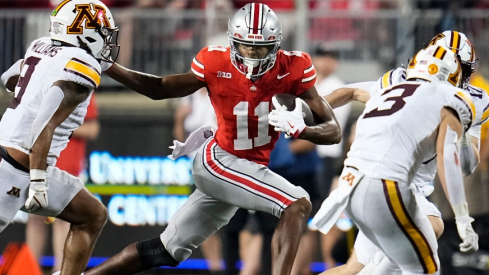Ohio State adds a veteran wide receiver from the transfer portal in former UTSA pass catcher Devin McCuin.
Money can't buy everything, but it's very difficult to buy anything without it.
I'll let this clip from an advanced economics course explain:
"Okay," you say, maybe a little too skeptically, "I think I understand the concept. But... how does one get money in the first place?"
Well, my friend, you earn it! By creating a product or performing a service, you can exchange that labor for any one of various fiat currencies, when then can be exchanged for things like peanuts (and perhaps almonds or walnuts). This is the way, the only way, that someone can become rich. There are no other ways. Quit asking. It's never happened! Every dollar, every cent, ever generated by anyone anywhere came from good ol' gumption and hard work. No exceptions.
Look at the Big Ten, for example. 14 different athletic departments in 11 different states, all busting their humps equally to generate a record 759 million dollars in the 2018 fiscal year. That's more than any other conference in the country by a wide margin, and beats out the Big Ten's previous best by several hundred million dollars. Most of these dollars came from television contracts, and who's to say that Rutgers losing to Buffalo wasn't just as significant financially as Ohio State in the Rose Bowl?
Uh, wait, that's not right.
Okay, so maybe some schools aren't pulling their weight.
Rutgers, Maryland, Minnesota, Illinois, and Wisconsin's athletic departments all take millions from either their universities or the students that attend them (or both), with the Scarlet Knights being particularly egregious in their graft. The poster child for why conference expansion is sometimes a really stupid idea collected nearly 12 million dollars in student fees (which, seriously, seems to constitute a punitive tax on students because not enough of them are paying American dollars to go watch Rutgers' many bad varsity teams) and still somehow ended up with a nearly three million dollar deficit.
Even more telling here is that Ohio State University as a whole, with massive financial obligations tied up in 36 different varsity sports, has largely been able to prevent the kind of major tuition increases seen at other schools in the Big Ten's footprint, and even within its own state, as it is the "cheapest" option between the University of Cincinnati, Ohio University, and Miami University. OSU also offers students a tuition guarantee to help ensure a consistent cost of education, which many other schools don't offer.
So that must mean that at least the Ohio State Athletic Department has earned every single bit of cash that they've ever gotten, right? The 185 million or so dollars that it generated in revenue for fiscal year 2016-17, for example, was achieved through generation after generation of coaches, student-athletes, and fans working in concert to develop the Buckeye sports brand, which can then be exported to the wider world at large for big time megabucks.
Most of those megabucks go back into the running of one of the largest athletic departments in the country. Expenses for Ohio State athletics ran north of 173 million dollars, as two very, very marketable revenue sports propped up a couple dozen or so non-revenue sports, leaving Gene Smith and company with a paltry 12 million dollars to build various wrestling and tennis facilities and other fun things.
And of course, football and basketball are the bell-cows for the entire operation.
Without the money gained from these sports, particularly football, most other Ohio State varsity sports would cease to exist. Goodbye, rowing and golf and lacrosse and soccer! Go to hell, softball, hockey, and fencing! Good riddance, baseball and maybe wrestling! How dare you not generate enough revenue to sustain yourselves! The market has spoken!
And yet, Ohio State deems it cool and good to keep these sports around.
As it turns out, all this cut-throat snobbery is wrong.
All Ohio State varsity sports contribute to a Buckeye ecosystem that gives hundreds of student-athletes the ability to compete in something that's been a lifelong passion for them as a person. And that has (deep, slow breaths here) important non monetary value to the university at a cultural and human level.

We cheer Buckeyes in every sport, no matter what it is, because they're athletes that represent Ohio State. Do I get as excited about synchronized swimming winning their billionth national championship as I would about the football team winning the Peach Bowl? Probably not, but the nice thing is that I can enjoy both. Does baseball and women's rowing occupy the same sized real estate in my consciousness as knowing how many threes Joey Lane attempted last season? Nope, but who cares? My personal interest doesn't determine value.
Where this becomes relevant to the Big Ten is that some may see it as unfair that the likes of Illinois gets equal time at the television money trough as Ohio State. I get this take; without Ohio State (and specifically Ohio State) being a nationally known collegiate force that regularly competes for championships, the 50 million-or-so payout to each individual school wouldn't be nearly as high.
Some fans might see this kind of largesse as a weakness, hoping that the school eventually breaks off from the obligations of the Big Ten, and throws off the shackles of the Rutgers and the Marylands and the Indianas of the world to seek media deals that would benefit Ohio State more directly and lucratively.
I understand the impulse, but I disagree with the idea. While corruption and mismanagement of funds should never be ignored and some schools probably won't ever be a good fit for the conference, I view Ohio State helping to subsidize the other Big Ten athletic departments in the same light that I view Ohio State football and men's basketball allowing other Buckeye varsity sports to exist.
The basic financials of the situation simply can't convey the social and cultural meaning that a cohesive Big Ten conference conveys to all of the sports that compete under its umbrella. I may not personally take part in jumping around, or waving to the hospital, or doing a kickass home whiteout, but I know they're important to the people who do, and that's enough for me. I'm proud that Ohio State athletics as a whole can facilitate that, in the same way that I'm happy that Ohio State football and men's basketball can help make possible all the non-revenue sports stories that we get to publish on a regular basis here in 11W.
The postscript to all of this is that the Big Ten needs to figure out who will be running this thing in the near future. Jim Delany's greatest achievement as Big Ten commissioner has probably been the creation of a steady flow of media-related dollars into the conference, but it'll be up to his successor to confront an increasingly fractured media landscape and convince the top-tier athletic departments in the Big Ten to stay on board.
Whoever it is will have to attempt to do the same thing that I've tried to do in this article: convince others of the importance of interconnectedness between schools and sports within those schools. Good luck to whoever ends up in that role, and I'm available for public speaking engagements to help whenever needed. Contact my agent, Kevin Harrish, at kevin@elevenwariors.com and we'll discuss rates.


